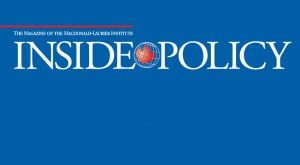 A new United Nations report on the accessibility of medicine in the developing world calls for loosening intellectual property regulations to make drugs cheaper. But, write Sean Speer and Richard Owens, this will only make it more difficult to provide drug access to the most impoverished.
A new United Nations report on the accessibility of medicine in the developing world calls for loosening intellectual property regulations to make drugs cheaper. But, write Sean Speer and Richard Owens, this will only make it more difficult to provide drug access to the most impoverished.
By Richard Owens and Sean Speer, Sept. 19, 2016
Just as good intentions line the road to perdition, so too they line the route along which bad public policy develops. Examples are legion of fine intentions disguising policy flaws. When in the nineteenth century England made it illegal for dogs to work, mindful of conditions for the poor creatures, the result was no leisure for dogs but that the owners, who could not afford to feed idle mouths, killed them.
And so on to the present. A new United Nations report on the accessibility of medicine in the developing world is just such a case study. The report, tabled last week and produced by a high-level panel including Canadian Stephen Lewis, calls for sweeping changes to intellectual property (IP) policy in order to expand the reach of proprietary medicines in the developing world. The stated goal of the panel is to reconcile “the incoherencies between international human rights, trade, IP rights and public health objectives.”
Increasing access for the world’s poor to patented medicines is a laudable objective. But weakening IP laws will undermine this goal. Good intentions meet inadvertent consequences.
French philosopher Frederic Bastiat famously wrote of the “seen” and “unseen” to convey the economic principle of opportunity cost in action. His parable of the broken window showed that people tend to concentrate on the visible and tangible costs resulting from a decision or activity and to fail to see potential costs “in the future.” Short-termism no matter how well-intended can produce negative consequences in the long-term if not properly considered and addressed.
The UN’s report falls victim to this type of short-termism by focusing on the seen (improving access to cheap drugs) at the expense of the unseen (the negative effect on innovation and new drug development).
Short-termism no matter how well-intended can produce negative consequences in the long-term if not properly considered and addressed.
Drug accessibility and affordability involve a myriad considerations including, among other things, development assistance programs, public infrastructure and education, and regulatory policy. Yet curiously the panel came to focus on IP, as its final report concedes.
It’s curious because the same report recognizes that “medical innovation has dramatically improved the lives of millions of people across the globe” and says that incentives are key driver of innovation. Somehow though it seems to misunderstand the key relationship between incentives and innovation. Good intentions can’t wish away the role of incentives in the development and distribution of life-saving medicines.
 Weakening intellectual property rules, including tougher patentability requirements, controlled pricing, and compulsory licensing, challenges the root of the whole global patent system whereby patent holders are given monopoly power for a certain period of time. The panel puts into question whether the patent-holder should be allowed that period of time at all, preferring, in its “seen” versus “unseen” fallacy, that everyone have immediate access to cheap drugs without properly considering the impact on incentives and innovation.
Weakening intellectual property rules, including tougher patentability requirements, controlled pricing, and compulsory licensing, challenges the root of the whole global patent system whereby patent holders are given monopoly power for a certain period of time. The panel puts into question whether the patent-holder should be allowed that period of time at all, preferring, in its “seen” versus “unseen” fallacy, that everyone have immediate access to cheap drugs without properly considering the impact on incentives and innovation.
While decrying so-called patent thickets and patents on research tools, the panel ignores both the important incentive effects of research tool patents and cogent research that demonstrates that so-called “thickets” actually have little impact on research. Here the panel seems blind to the dynamics and impact of the innovation economy. It is blind to these dynamics and impacts in the less developed world, too, by failing to account for the risks to foreign investment, technology transfer, and ultimately drug accessibility and affordability that weakening patent protection there will engender.
Firms dedicate financial resources to early-stage research and development on the understanding that, if they prove fruitful, the firm will able to earn a return on investment due to the protections inherent in the patent system. Far from antithetical to IP rules, it is inherent that patent holders may earn outsize returns with the promise of a bonanza (while these are rare) being part of the prize system that drives innovation. Weakening the IP rules would change these incentives and risk discouraging new private investment and in turn life-saving medical innovations.
Some argue that drug companies earn too much money from their discoveries, a mistaken opinion based on the fact that drug companies top some lists of profitable entities. But theirs is a risky and expensive business and one ought to expect that just as they are at the top so too are they at the bottom of the lists, as a proper risk distribution would inevitably predict. Put differently: we have a profit and loss system with profit based on patents rewarding smart risk-taking and loss punishing wrong-headed risks—risks better taken by private entrepreneurs than cash-strapped government bureaucracies.
Weakening the IP rules would change these incentives and risk discouraging new private investment and in turn life-saving medical innovations.
Another point the panel raises is that private drug companies benefit from public research investment. This is probably true to some degree but the panel doesn’t quantify it. It is also true to say that public institutions benefit from drug company financing, and that drug companies pay royalties to public patent holders. And it is impossible to say to what extent public research in general makes a significant difference to the huge costs of producing and distributing drugs. Yet the panel would have these accounted for, in several categories, on a per drug basis, as though there were a one-to-one substitution for private costs.
It is ironic that the panel trades off private activity for public and proposes massive new public investment in medical innovation to make up for any “unmet need.” It is counterproductive to disrupt the one aspect of drug accessibility and affordability that is producing results, in order to fund a costlier and less effective response. That isn’t to say that there’s no role for public or charitable intervention to tackle tropical diseases and bacterial infections, which the panel reports receive too little attention. In fact these interventions do take place, and on a large scale. But they operate as they should in parallel to, and not instead of, the commercial economy.
 In addition to limiting patent protection, the panel contemplates levies on pharmaceutical companies, accountability to meet public accessibility objectives, and disclosure of R&D costs, with a view to reducing prices. These measures will not reduce drug prices—they will increase them. Consumers bear corporate costs in the form of prices of goods. When costs increase, prices invariably go up, not down. The alternative is called insolvency. Subsidizing drug access for the world’s poor is an idea to consider, subject first to other considerations such as delivery capacity and the extant local price. But to choose, out of all actors, the industry that invents these life-saving treatments to provide such subsidies is worse than random, it is perverse.
In addition to limiting patent protection, the panel contemplates levies on pharmaceutical companies, accountability to meet public accessibility objectives, and disclosure of R&D costs, with a view to reducing prices. These measures will not reduce drug prices—they will increase them. Consumers bear corporate costs in the form of prices of goods. When costs increase, prices invariably go up, not down. The alternative is called insolvency. Subsidizing drug access for the world’s poor is an idea to consider, subject first to other considerations such as delivery capacity and the extant local price. But to choose, out of all actors, the industry that invents these life-saving treatments to provide such subsidies is worse than random, it is perverse.
The panel overstates the impact of patents on accessibility. The reality is that drugs often are not patented in less developed countries at all; it is not worthwhile for the companies to pursue such patents because the market is so small. Drug companies do have programmes that make their patented drugs available to the poor domestically and internationally. And prices are normally lower in poorer jurisdictions; discriminatory pricing of IP-protected goods for different markets just makes sense.
To weaken IP laws and attack drug companies may generate media headlines and emotive responses but will ultimately hurt more than help.
But prices cannot be reduced to zero if corporations are to fulfil their fiduciary responsibilities to shareholders, because of the need to recoup enormous costs of research and development, manufacturing, regulatory compliance and distribution, as well as the extensive potential liabilities of the market for pharmaceuticals.
Re-thinking humanitarian assistance programs to focus on life-saving drugs is one option to achieve the UN’s objectives. Bulk purchasing and pooling drug purchases to enhance economies-of-scale is another.
To weaken IP laws and attack drug companies may generate media headlines and emotive responses but will ultimately hurt more than help. Governments would therefore be wise to eschew the panel’s recommendations and instead focus on the slow yet steady progress to a real solution that the existing drug economy provides.
We can’t let good intentions and bad thinking lead us to bad public policy. Policy must account for the seen and unseen.
Richard Owens and Sean Speer are Munk senior fellows at the Macdonald-Laurier Institute.




